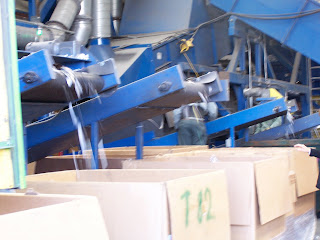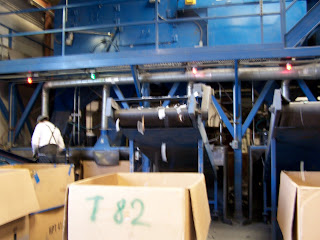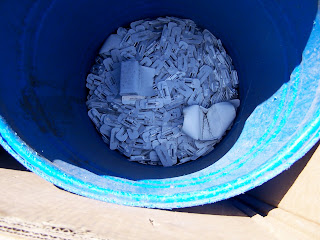About three weeks ago I visited an e-waste recycling facility for a documentary I was making with two other girls for a class (I will post it soon : ) ). Before going I thought e-waste was recycled by having people disassemble each item by hand, pulling out all of the important materials, and separating them all meticulously. Oh how naïve I was.
In reality, my imagined method of e-waste would have us completely buried in mounds of it. It would take forever for workers to break down each and every item. However, it would be significantly more efficient at material recovery. So what really happens with e-waste? Just saying this makes me shudder: it goes through a shredder.
First they dump out the e-waste by using a forklift and tipping over a full metal bin. They sort through it a bit to remove all long cords that can get stuck in the shredder (I saw them take out Christmas lights and some other long, unattached cords). They also take out glass that can be easily removed (the plate in the microwave and the glass in scanners).
They toss it onto the conveyer belt that takes into the belly of the shredder.
I included this image because I think people do not really think about what really constitutes e-waste. I think most people only consider TV’s and computers. But really, e-waste is any item that runs on electricity, either through a batter or a cord. This mean that alarm clocks, watches, refrigerators, electric stoves and other appliances, video games, ect. are all e-waste. I cannot even begin to imaging how many of these items as a country we all have. It’s just too much.
The main part of the shredder where it is broken down into small pieces was just a big large blue square in the center of the room. I tried to get pictures of it, but it was blocked by large pallets and other things that have been through the shedder. The entire machine takes up a huge warehouse.

Afterwards the materials go through shakers, which sort the materials by weight. This is intended to separate the different kinds of metals and plastics. It is inefficient, however, and all different kinds of materials end up in these large boxes that may, for the most part, be one material. These boxes are then packaged and shipped to other countries (in this case they only told us about shipping to Texas and a company in Canada) who will reuse the items and make them into something new. The metals are typically melted down and refined before being molded into a new product, while the plastic is compressed or shredded down further before being down-graded. What is down-grading? It’s when a product has to be used at a lower quality. In many cases recycled plastic cannot be recreated into things that hold liquids and instead are made into clothing or other items.


Although the majority of the e-waste does go through this shredder, anything with a cathode ray tube (CRT) are recycled by hand (including older TVs and computer monitors). Computer towers and laptops are also recycled by hand because the parts in them are more valuable when sent off individually (all of the circuit boards, cd drives, fans, ect. are piled together and sent to different companies for different purposes, but unless they are still in excellent working conditions, they will be melted down and turned into something else).
The plastic is then sorted by color: white, black, and colored. What you see in the picture above is their colored pile. This is done so it is easier to recycle into something new and the colors are homogenous.
This picture, and the one below, are a quick reminder of all of the things we use every day without considering where they go. The picture below is a container full of the plastic pieces that come with every hand held apple product for docking. I can’t even imagine how many of these things are created every year.

I also never thought about all of the DVDs, CDs, and other storage devices.
Hopefully this makes recycling more clear and it helps everyone to understand why it is so important to keep our products as long as possible and to make sure they last. Even though it’s good to recycle, its even better to use less electric products, and to use them until they are absolutely non-functional anymore.
For more information about responsible recycling near you check this out.
Thank you to ESC Refining for allowing my group to film part of our documentary as well as to answering all of our questions.














This post gives a clear image of how recycling is actually done. One must definitely consider to recycle mobile or other electronic products to help save the environment.
Separation of plastics of phone handsets is quite simple manually and people who make cash for mobile is also quite easy online. But recycling of the plastics is not easy and smelter is the process in which plastics are recycled.